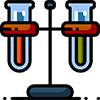Mathematics: Course Catalog - High School
 FOUR credits required.
FOUR credits required.
*Algebra 1, or an equivalent course is required.
*Geometry or an equivalent course is required.
*Algebra 1A, 1B, Algebra 1or Algebra 1Honors are equivalent courses; only one will count.
College Preparatory Track. (Meets the requirements for the Bright Futures Scholarship) A total of four math credits, all at the Algebra 1level and above.
The Standard Diploma Track still requires Algebra 1or an equivalent course(s) and Geometry, but can then be followed by lower level courses.
1200310 ALGEBRA 1
This course is a full year, high school credit course that is intended for the student who has successfully mastered the core algebraic concepts covered in the prerequisite course, Pre-Algebra. Within the Algebra I course, the student will explore basic algebraic fundamentals such as evaluating, creating, solving and graphing linear, quadratic, and polynomial functions.
Upon successfully completing the course, the student should have mastered the following concepts:
Solve single variable, absolute value, and linear systems of equations.
Solve and graph single variable, absolute value, and linear inequalities.
Evaluate, solve, and graph linear and quadratic functions as well as conceptualize the relationship between the independent and dependent variable of a function.
Understand and know how to apply the distance, midpoint, and slope formulas as well as the Pythagorean theorem.
Form an equation of a line using the slope-intercept, point-slope and standard forms of a line.
Organize data in the form of a table or matrix; perform complex matrix operations such as multiplication, evaluating the determinant, and solving a system of linear equations using Cramer's Rule.
Apply basic fundamental rules of exponents.
Be able to construct a formula or equation necessary to solve algebraic word problems involving area, perimeter, and linear systems of equations, basic probability and statistical reasoning, distance, and compounding interest.
Evaluate rational expressions and solve equations with rational expressions.
Simplify and perform operations with radical expressions and polynomials.
1200320 ALGEBRA 1 HONORS
This course provides a rigorous and in-depth study of Algebra, emphasizing deductive reasoning skills, as a foundation for more advanced mathematics courses and to develop the skills needed to solve mathematical problems. Topics covered in Algebra 1 Honors shall include, but not be limited to:
quantitative reasoning;
laws of integral and rational exponents;
contextualizing situations to create equations and inequalities;
solving and the justification of solution of linear,
simple exponential, quadratic, and simple radical equations & inequalities;
working with arithmetic and geometric sequences;
solving and the justification of solution of linear and quadratic systems of equations and inequalities;
graphing linear, exponential, and quadratic two variable equations;
understanding the concept of a function and then use that understanding to construct new functions (functions limited to: linear, quadratic, exponential, and radical functions);
analyzing functions and their inherent properties;
finding the inverse of linear and quadratic functions;
creating linear and exponential models of real world data and then use the models to make predictions;
simplifying and factoring polynomial expressions;
proving polynomial identities;
simplifying radical expressions;
summarizing, representing, and interpreting data on single count or measurement data, and two categorical variables;
using the mean and standard distribution to estimate population percentages.
1200370 ALGEBRA 1A
1200380 ALGEBRA 1B
The combination of these two courses refines the algebraic concepts and processes learned in middle school mathematics courses and then uses that knowledge to solve a variety of real world and mathematical problems. Topics covered in Algebra 1A & Algebra 1B shall include, but not be limited to:
quantitative reasoning; laws of integral and rational exponents;
contextualizing situations to create equations and inequalities; solving and the justification of solution of linear, simple exponential, and quadratic equations & inequalities;
solving and the justification of solution of linear systems of equations and inequalities;
graphing linear, exponential, and quadratic two variable equations; understanding the concept of a function and then use that understanding to construct new functions(functions limited to: linear, quadratic, exponential, and radical functions);
analyzing functions and their inherent properties;
creating linear and exponential models of real world data and then use the models to make predictions;
simplifying and factoring polynomial expressions; simplifying radical expressions;
summarizing, representing, and interpreting data on single count or measurement data, and two categorical variables.
1206310 GEOMETRY
A full year, high school math course for the student who has successfully completed the prerequisite course, Algebra 1. The course focuses on the skills and methods of linear, coordinate, and plane geometry. In it, students will gain solid experience with geometric calculations and coordinate plane graphing, methods of formal proof, and techniques of construction.
By the end of the course, students will be expected to do the following:
Understand defined terms, axioms, postulates, and theories.
Apply rules of formal logic and construct proofs in two-column format.
Know how to solve for angles given parallels, perpendiculars, and transversals.
Demonstrate how to solve for sides and angles of triangles, quadrilaterals, and polygons.
Understand trigonometric ratios and know how to use them to solve for unknown sides and angles in given triangles as well as application word problems.
Be able to determine arcs, chords, and sectors of circles.
Calculate perimeter, area, and volume of figures and solids.
Graph lines and determine slopes, midpoints, and distances.
Make geometric constructions on paper.
Represent results of motion geometry (translation, rotation, reflection, dilation).
1206320 GEOMETRY HONORS
This course gives a rigorous in-depth study of geometry with emphasis on methods of proof and formal language of Topics shall include, but not be limited to:
constructing and determining the validity of logical statements;
construction of various abstract geometric objects;
transforming geometric objects on the Euclidian and Descartes plane;
proving theorems involving the intersection of parallel lines and segments;
proving theorems involving triangles, quadrilaterals, & circles and their inherent properties and then use these properties to solve problems involving these figures;
solving problems involving the use of the Pythagorean Theorem, and the Sine, Cosine, and Tangent ratios;
proving the validity of the Law of Sines and then use it and the Law of Cosines to find unknown measures in triangles; proving theorems involving quadrilaterals and their inherent properties and then use these properties to solve problems involving quadrilaterals;
deriving and applying formulas for finding perimeter, area, volume, & surface area;
deriving the equations of the parabola, hyperbola, and ellipse.
1200330 ALGEBRA 2
Algebra 2 is a full-year, high school math course intended for the student who has successfully completed the prerequisite course Algebra 1. This course focuses on algebraic techniques and methods in order to develop student understanding of advanced number theory, concepts involving linear, quadratic and polynomial functions, and pre-calculus theories. This course also integrates geometric concepts and skills throughout the units, as well as introducing students to basic trigonometric identities and problem solving.
By the end of the course, students will be expected to do the following:
•Understand set notation and the structure of mathematical systems.
•Know how to use functional notation and operations on functions.
•Simplify and solve algebraic fractions.
•Perform operations on polynomials, including factoring, long division, and synthetic division.
•Solve algebraic word problems involving mixtures, money, integers, and work.
•Evaluate and solve radical expressions and equations.
•Solve systems of equations with graphing, substitution, and matrices.
•Graph and solve quadratic equations, including conic sections.
•Graph and solve exponential and logarithmic equations.
•Calculate permutations, combinations, and complex probabilities.
1200340 ALGEBRA 2 HONORS
This course continues in the study of the structure of algebra and geometry with emphasis on theory, proof and development of formulas in order to provide the foundation for applying these skills to Pre- Calculus, Statistics, and other mathematical and scientific fields. Topics shall include, but not be limited to: studying the following common functions: square root, exponential, logarithmic, polynomial, rational, cube root, piecewise defined, and trigonometric; being able to describe the key features and then sketch the graph of a function; intercepts; intervals where the function is increasing, decreasing, positive, or negative; relative maximums and minimums; symmetries; and end behavior; understanding the structure and properties of the complex number system; using arithmetic and geometric sequences & series to solve problems; understanding the concept of an inverse relation/function; performing various function transformations fluently; calculating and interpreting the rate of change of a function; understanding the structure of polynomial expressions in order to be able to fluently perform factorizations on polynomials; proving basic theorems about polynomials; being able to fluently solve polynomial equations over the complex number system; being able to contextualize a real world situation into a common function the best fits the data; fundamentally understanding the unit circle; using radian measure to solve problems; understanding the basic concepts of independent and conditional probability; understanding and evaluating random processes for a given set of statistical data (Non- inferential statistics); applying the general probabilistic multiplication rule; using permutations and combinations to solve problems.
1200700 MATH FOR COLLEGE READINESS (FLVS)
Are you ready for college success? This course is intended for grade 11 or 12 students, whose test scores on the Postsecondary Educational Readiness Test (P.E.R.T.) are at or below the established cut scores for mathematics, indicating that they are not yet “college ready” in mathematics or simply need some additional instruction in content to prepare them for success in college level mathematics. This course incorporates the Common Core Standards for Mathematical Practices as well as the following Common Core Standards for Mathematical Content: Expressions and Equations, the Number System, Functions, Algebra, Geometry, Number and Quantity, Statistics and Probability, and the Common Core Standards for High School Modeling. The standards align with the Mathematics Postsecondary Readiness Competencies deemed necessary for entry-level college courses.
1202300 CALCULUS (FLVS)
An interactive course framework combines with the exciting on-line course delivery to make calculus an adventure. The course includes a study of limits, continuity, differentiation, and integration of algebraic, trigonometric, and transcendental functions, and the applications of derivatives and integrals.
Segment 1:
Review of Function Terminology and More, Graphing Calculators, Compositions and Transformations of Functions, Some Common Functions, Introduction to Limits, Properties of Limits, Limits Involving Infinity, Continuity, Applications of Limits, The Derivative, Rules of Differentiation, Trigonometric Derivatives and the Chain Rule, Inverse Functions, Exponential and Logarithmic Functions, Derivatives of Exponential, Logarithmic, and Inverse Trig Functions, Implicit Differentiation, Analyzing Functions Part I: Curve Sketching, Analyzing Functions Part II: Maximums and Minimums, Applied Maximum and Minimum Problems, Distance, Velocity, Acceleration, and Rectilinear Motion, Related Rates, The Mean Value Theorem and L'Hôpital's Rule, Linearization
Segment 2:
Area Approximation and Riemann Sums, Introduction to the Definite Integral, the Fundamental Theorem of Calculus, Integrals and Antiderivatives, Integration by Substitution, The Definite Integral, Finding the Area Under and Between Curves, Volume by Discs (Slicing), Average Value of a Function and Rectilinear Motion Revisited, Differential Equations – An Introduction, Initial Value Problems and Slope Fields , Numerical Approximation Methods with Integrals, Exploring the Graphs of f, f Prime, and f Double Prime, Relative Rates of Growth, Using Calculus with Data in a Table, Functions Defined by Integrals
1202340 PRE-CALCULUS
A full-year, high school credit course that is intended for the student who has successfully mastered the core algebraic and conceptual geometric concepts covered in the prerequisite courses: Algebra 1, Geometry, and Algebra 2. The course primarily focuses on the skills and methods of analytic geometry and trigonometry while investigating further relationships in functions, probability, number theory, limits, and the introduction of derivatives.
Upon successfully completing the course, students should have mastered the following concepts:
•Perform operations on functions including composition and inverses.
•Graph, evaluate, and solve exponential and logarithmic functions and equations.
•Utilize the unit circle in evaluating trigonometric identities; prove trigonometric identities; graph trigonometric functions and their inverses.
•Solve application problems involving right triangle trigonometry, special right triangles, and law of sines and cosines.
•Convert between Cartesian and polar forms; graph equations in polar coordinates.
•Graph and solve quadratic equations that include conic sections.
•Calculate probabilities, combinations, and permutations.
•Calculate summations and limits of functions.
•Relate analytical operations of limits, slope of a tangent line, and the definition of a derivative.
1211300 TRIGONOMETRY HONORS (.5 Credit Course)
Trigonometry is for high school students who have successfully completed Algebra 1, Geometry, and Algebra 2. The materials cover a development of trigonometry from right triangle trigonometry to oblique triangles and the polar plane. Throughout the course, students will develop trigonometric formulas and use them in real-world applications, evaluate trigonometric proofs using complex trigonometric identities and solving trigonometric equations with regard to the unit circle.
The course seeks to help students expand their knowledge and skills so that they may achieve the following goals:
•Use trigonometry as a tool for indirect measurement.
•Model natural phenomenon with trigonometric functions.
•Perform operations with complex numbers using trigonometry.
•Use trigonometric identities to evaluate trigonometric proofs and solve trigonometric equations with regard to the unit circle.
•Solve for unknown sides and angles of right and oblique triangles using right triangle trigonometry, law of sines and law of cosines.
In attaining these goals, students will begin to see the "big picture" of mathematics and understand how numeric, algebraic, and geometric concepts are woven together to build a foundation for higher mathematical thinking.
ADVANCE PLACEMENT CALCULUS AB (FLVS)
The course includes a study of limits, continuity, differentiation, and integration of algebraic, trigonometric, and transcendental functions, and the applications of derivatives and integrals.
Segment 1:
Review of Function Terminology and More, Graphing Calculators, Compositions and Transformations of Functions, Some Common Functions, Introduction to Limits, Properties of Limits, Limits Involving Infinity, Continuity, Applications of Limits, The Derivative, Rules of Differentiation, Trigonometric Derivatives and the Chain Rule, Inverse Functions, Exponential and Logarithmic Functions, Derivatives of Exponential, Logarithmic, and Inverse Trig Functions, Implicit Differentiation, Analyzing Functions Part I: Curve Sketching, Analyzing Functions Part II: Maximums and Minimums, Applied Maximum and Minimum Problems, Distance, Velocity, Acceleration, and Rectilinear Motion, Related Rates, The Mean Value Theorem and L'Hôpital's Rule, Linearization
Segment 2:
Area Approximation and Riemann Sums, Introduction to the Definite Integral, The Fundamental Theorem of Calculus, Integrals and Antiderivatives, Integration by Substitution, The Definite Integral, Volume by Discs (Slicing), Finding the Area Under and Between Curves, Average Value of a Function and Rectilinear Motion Revisited, Differential Equations – An Introduction, Initial Value Problems and Slope Fields , Numerical Approximation Methods with Integrals, Exploring the Graphs of f, f Prime, and f Double Prime, Using Calculus with Data in a Table, Functions Defined By Integrals, AP Exam Review and Test Taking Tips and Practice
ADVANCE PLACEMENT CALCULUS BC (FLVS)
The course includes a study of limits, continuity, differentiation, and integration of algebraic, trigonometric, and transcendental functions; the applications of derivatives and integrals; infinite series; parametric equations; and polar equations.
Segment 1:
Review of Function Terminology and More, Graphing Calculators, Compositions and Transformations of Functions, Some Common Functions, Introduction to Limits, Properties of Limits, Limits Involving Infinity, Continuity, Applications of Limits, The Derivative, Rules of Differentiation, Trigonometric Derivatives and the Chain Rule, Inverse Functions, Exponential and Logarithmic Functions, Derivatives of Exponential, Logarithmic, and Inverse Trig Functions, Implicit Differentiation, Analyzing Functions Part I: Curve Sketching, Analyzing Functions Part II: Maximums and Minimums, Applied Maximum and Minimum Problems, Distance, Velocity, Acceleration, and Rectilinear Motion, Related Rates, The Mean Value Theorem and L'Hôpital's Rule, Linearization, Area Approximation and Riemann Sums, Introduction to the Definite Integral, The Fundamental Theorem of Calculus, Integrals and Antiderivatives, Integration by Substitution, The Definite Integral, Finding the Area Under and Between Curves, Volume by Discs (Slicing), Average Value of a Function and Rectilinear Motion Revisited
Segment 2:
Differential Equations – An Introduction, Initial Value Problems and Slope Fields , Numerical Approximation Methods with Integrals, Exploring the Graphs of f, f Prime, and f Double Prime, Relative Rates of Growth, Using Calculus with Data in a Table, Functions Defined by Integrals, Integration by Parts, Integration Using Partial Fractions, Improper Integrals, Parametric Curves, Polar Curves, Vector Curves, Length of Planar Curves, Area of Planar Curves (Polar Curves only), Series, Convergence, Tests for Convergence Parts I & II, Error Bound, Maclaurin Series, Taylor Series and Error Bound, Power Series, Radius and Interval of Convergence of Power Series, AP Exam Review and Test Taking Tips and Practice
MAT1033 INTERMEDITATE ALGEBRA
A college Dual Enrollment Course that is counted as one half credit per Florida Department of Education guidelines.
Lower-Division College Credit (Does not count as a math for Bright Futures or most AA derees.)
Prerequisites: MAT 0024 or appropriate placement examination score
This course provides the foundation for higher-level courses in Algebra through the development of algebraic skills, as well as examination of the basic mathematical principles underlying those skills. The course topics include factoring, rational expressions, linear and quadratic equations, rational exponents, radical expressions, graphing, systems of equations and inequalities, complex numbers, rational equations, functions, proportion and variation, and applications.
MAC1105 COLLEGE ALGEBRA
A college Dual Enrollment Course that is counted as two, one half credit grades equaling one credit, per Florida Department of Education guidelines.
This course is intended for students whose programs of study require a strong background in college algebra, or those who need preparation for more advanced mathematics courses. Topics include general properties of functions; the graphs of linear, absolute value, quadratic, rational, radical, exponential, and logarithmic functions; equations and inequalities associated with these functions; graphs and equations of circles; and systems of equations and inequalities. A graphing calculator (TI-83 or equivalent) is required.
MGF1106 TOPICS IN MATHEMATICS
A college Dual Enrollment Course that is counted as two, one half credit grades equaling one credit, per Florida Department of Education guidelines.
This course introduces students to non-algebraic principles, probability, descriptive statistics, geometry, numeration systems (including the metric system), and deductive and inductive reasoning. A scientific calculator is required (graphing calculators are allowed).
STA2023 INTRODUCTION TO PROBABILITY AND STATISTICS
A college Dual Enrollment Course that is counted as two, one half credit grades equaling one credit, per Florida Department of Education guidelines.
This course provides introductory experience in organizing and analyzing masses of statistical data, and in drawing conclusions based on the data. Topics include descriptive statistics, hypothesis testing with binomial and normal distributions, single and two sample analysis, chi-square, student’s t, correlation, and regression. A statistical calculator is required. A graphing calculator (TI-83) is recommended.
LIBERAL ARTS MATH 1& 2











